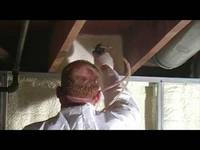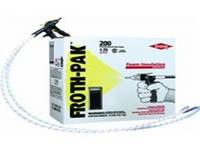Tips for insulating a drafty basement

Photo by: WN.com
-George R. Canton, Mich.
Hi George,
This is a common problem for homeowners because this particular area is usually an afterthought for insulation until after the house is built. The area is called the rim joist, or band joist, and is a perfect area for air penetration and sometimes even critter infiltration.
Sealing the gap correctly can stop air leaks and can dramatically improve comfort and efficiency of your basement, and of course... will result in lower utility bills!
There is a product our company has used on several occasions called Froth-Pak where there were similar issues with cold, unsealed and drafty basements. We have received positive feedback regarding the results; it's effective at stopping air leaks and serving as an insulator.
Here’s some more good news: it's a project that the average do-it-yourselfer can complete himself. However, be prepared: the price is not cheap, but well worth the investment. $370-425 for approximately 200 square feet by one inch thick.
Froth-Pak, made by Dow Building Solutions, is a spray foam insulation kit which is similar to an industrial size “GreatStuff” insulation product. According to the Dow website, the R-value is 6.99 per 1.75 inch of foam. Another similar product is available from FOMO. When applied correctly to the joist, these products will expand, filling the cavity.

Photo from google.com/products
Here is a tip from one of our technicians, Mike M: if you need to get the foam in hard-to-reach crevices such as behind an air duct or a bumpout of your home, tape a drinking straw to the end of the spray nozzle. The diameter is a perfect fit over the nozzle, and it will act as an extension, allowing you to spray into the hard-to-reach areas.
Watch an application in progress on YouTube.
While foam insulation is relatively simple to use, be sure to wear protective eye goggles, a mask and disposable clothing. Be prepared, because it will stick to everything. If it does fall on a finished surface, be sure to let it harden and then pop it off! Enjoy and stay warm.
Paul is a State of Michigan Licensed Builder. Paul serves as President and founding member of Nationally franchised HandyPro Handyman Service, servicing Washtenaw, Wayne and Oakland Counties. www.handypro.com. Listen to Paul every Saturday at 11 a.m. on “It’s Your Home, Let’s Talk About It” WAAM Talk 1600AM. Email questions or comments to kpaul@handypro.com


Comments
Keith A. Paul
Mon, Mar 14, 2011 : 1:19 p.m.
a2phiggy - It's stated the product can spray approximately 6 feet, therefore it may fill part of the wall cavity. Although blowing in from the top down with a fiberglass or cellulose would be my suggestion for DIY'ers. Plus this foam will exert pressure in restricted areas and if you cannot see exactly were your spraying it may cause damage due to expansion. KJMClark - Preparation is key, ensure anything loose debris is removed for a tight seal. I haven't seen any information on humidity levels affecting the foam. It skins over within 40 seconds and dries within minutes. It appears Tigerfoam is very similar, both are a 2 -component spray polyurethane foam insulation kits. Although Tigerfoam states its R value is higher at R7 per inch. FredMax - Drawing fresh air into the house is a good step to take for a many reasons including stopping negative pressure in your home causing back draft from combustion appliances hazards such as hot water heater, the infiltration of radon etc. According to Steve Toeppner for Well Home, (A Masco Home Services Inc. Local company specializing in home energy conservation, 877-721-5907), ensure you have a controlled damper installed to help with controlling the air intake. Therefore sealing off the any air leaks would still be beneficial for controlled purposes.
FredMax
Sat, Mar 12, 2011 : 3:37 p.m.
My heating & cooling guy assured me that my furnace requires a cool air input, thus he installed an open pipe about a foot in diameter that freely draws from the outside and into my basement to an "arbitrary" location "near" the furnace. I don't know how common this setup is in other homes, is there a benefit in fixing smaller air leaks even with this setup?
KJMClark
Sat, Mar 12, 2011 : 11:42 a.m.
This is one of my projects for this year. I'm assuming I should wait to do this until things warm up, for ventilation reasons. Do I need to clean out those spaces before I spray stuff in? Should I try to lower the humidity before I get started? (Ie. wait for a dry spell, run the dehumidifier?) Tiger foam is the same thing right? Is there any difference between all these foams, or should decide how much I need and just get whatever's cheapest?
a2phiggy
Fri, Mar 11, 2011 : 9:01 p.m.
We had our home reinsulated with blown insulation into mortar joints throughout the brick walls - but there are still areas that are cold, perhaps due to inaccessibility issues in the wall. Is there a way to use this product to blow up a wall cavity from the basement? Thanks.
Keith A. Paul
Fri, Mar 11, 2011 : 8:11 p.m.
Great Question Townie, Here is the what it states from the product information form the website. • FROTH-PAK™ products should not be used around heaters, furnaces, fireplaces, recessed lighting fixtures or other applications where the foam may come in contact with heat-conducting surfaces. FRO TH-PAK™ foam is combustible and will burn if exposed to open flame or sparks from high-energy sources. Do not expose to temperatures above 240°F. <a href="http://building.dow.com/na/en/products/insulation/frothpakfs.htm" rel='nofollow'>http://building.dow.com/na/en/products/insulation/frothpakfs.htm</a>
Craig Lounsbury
Fri, Mar 11, 2011 : 6:17 p.m.
"However, be prepared: the price is not cheap, but well worth the investment. $370-425 for approximately 200 square feet by one inch thick." If price is an issue but time isn't buy a couple 4x8 sheets of ridged foam board, cut it to size with a drywall saw for your various cavities, jam it in with a compatible adhesive then finish the edges with a can of "great stuff" You can do your basement for 40-50 bucks. Both the seal and the R value are as good, It may be more time consuming but at a considerable savings
Townie
Fri, Mar 11, 2011 : 6:06 p.m.
A question: No mention here of gas fired appliances in the normal basement (hot water heater, furnace). What happens when the off gassing of the foam compounds occurs and a flame from one of the two appliances is introduced?